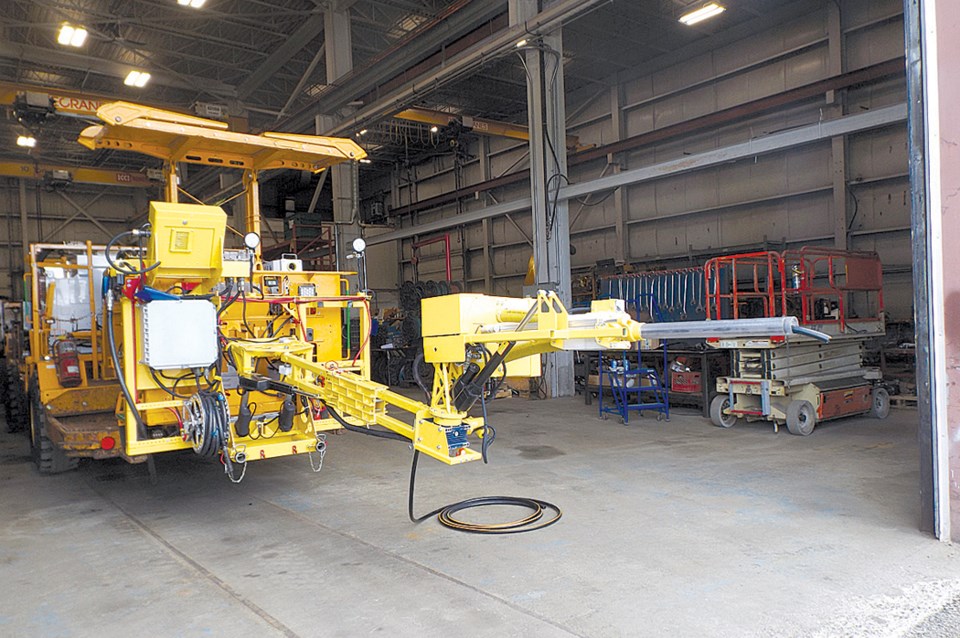A former Flin Flon couple is literally breaking new ground with an invention that is keeping safe miners who are cleaning and loading blast holes in a mine’s rock face.
Nine years after establishing their Sudbury, ON-based consulting firm, Rod and Clara Steele received a call from a manager at the nearby Vale Canada’s Coleman nickel mine.
An employee at that site had been killed by a 14-tonne slip of rock that had fallen on him at the mine face, more than 4,200 feet underground. The manager had promised the
dead man’s daughter he would do whatever he could to ensure a similar accident would not happen again.
Before then, TesMan was consulting with mines in the design and development of technologies to improve underground mining practices. The company’s team of mining, mechanical and electrical engineers had devised software and equipment to improve industrial safety and productivity.
Rod is a mining engineer who was educated at England’s Leeds University and previously worked in South Africa, Australia, United States and throughout Canada, including with Hudson Bay Mining and Smelting Company in Flin Flon, now known as Hudbay.
Management at the Coleman Mine approached Rod to develop an alternative method for miners to clean and load blast holes at the mine face.
After failing to find a technology that could accomplish the job, Rod and his team determined that the solution was to automate the operation from a distance.
This meant developing a new system.
“We were brought in as consultants following the incident, and the investigation found that, in actual fact, no one had done anything wrong,” Rod said from Sudbury last weekend. “In essence, we were looking for a space-shuttle response. We had to come up with something different that didn’t exist before.”
A little over five years after the project began, the first remote loader will be put to use in the Coleman Mine, with other operations from as far away as Mexico and Chile showing interest in it.
The technology was operated in a test mine this summer, with miners operating it and providing feedback to TesMan.
This user feedback has resulted in the adaptation of two additional features, which will be brought out next year in the upgraded version of the technology.
The remote loader is known as the SP-TRL – the Steve Perry - TesMan Remote Loader – in honour of the 47-year-old miner killed in the 2012 Coleman incident.
The machine has several tools, including an air hose that feeds into the blast holes to blow out moisture and loose debris; a hammer to break up obstructions; an endoscope so the remote loader operator can see inside the hole; and an auger to clean the holes near the bottom of the face where material tends to pile up.
Miners operate the loader up to 17 feet away from the face. They manoeuvre the tools through a feed unit on a boom using joysticks and a touch screen. This way, workers no longer need to manually clean and load the blast holes, keeping them out of the risk zone at the rock face.
“Now that cleaning and loading can be accomplished remotely and you can do parts of tunnelling and cycling remotely, the huge benefit is, firstly, no one needs to go in [directly to the mine face],” said Rod.
“Secondly, the cost of doing this work is dramatically reduced. Before, the previous technologies required the men and women to be right in there to do the work. With the remote loader, we’re looking at
reducing time and, ultimately, being safer.”
TesMan – which is named after the Steele’s daughters, Tessa and Mandy – is marketing the remote loader through Industrial Fabrication Inc.
Industrial Fabrication manufactures Minecat underground mining utility vehicles and operates a sales and service division.
“They came to us and asked if we’d be interested in dealing through them,” said Rod. “It’s a nice marriage with all of our products, because they are already using our technology to complement their existing line of products.”
Minecat is looking at distribution options in Australia, but Rod noted that they are setting their focus on the Canadian mining industry for the time being.
The SP-TRL has garnered interest from outside the mining industry as well. At the end of September, a production crew from Discovery’s Daily Planet television show shot a segment on the technology. The segment is scheduled to run in the next couple of months.
Rod met Clara in 1990 when both worked for the Hudson Bay Mining and Smelting Company. Clara worked in administration and health and safety, while Rod was an engineer.
Clara, the daughter of Bev and Gail Baker, was raised in Flin Flon. The couple moved to Midland, ON when Rod was offered a job there in 1993. They ultimately arrived in Sudbury in 1997, where Rod worked in the mining industry and where the Steeles started TesMan, which was incorporated in 2003.
The couple operated their consulting firm on the side until they went full time with the company
in 2007.
“Flin Flon is always going to be my home,” said Clara, who handles the finance and safety aspect of the business. “I was home this summer for the Homecoming and it was a fantastic experience. I got to see people I haven’t seen in 30 years. Flin Flon will always have a special place in my heart.”




